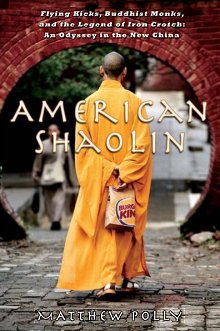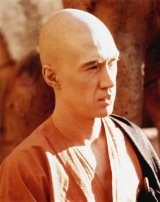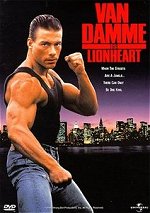From American Shaolin, a autobiographical tale of Matthew Polly’s intensive training at the modern Shaolin Temple:

With most TV programming so dull, the boys at Shaolin were kungfu movie freaks, constantly visiting Shaolin’s multiplex to watch the latest blood-spattered Hong Kong releases on VHS. Wanting to undermine the assumption that laowai (non-Chinese outsiders) suck at martial arts, I brought VHS copies of Steven Seagal’s Above the Law, David Carradine’s Kung Fu, and Jean-Claude Van Damme’s Lionheart back to Shaolin after winter vacation.
The monks were used to highly fictionalized portrayals of the Shaolin temple, so they weren’t bothered by the fantasy version of Shaolin in David Carrdine’s Kung Fu. They were, however, shocked by the casting of David Carradine.
“The actor is a laowai,” I said. “He’s pretending to be half-Chinese.”
“That explains why his kungfu is so terrible,” Little Tiger said, as he ducked to the back row to avoid another cuff from monk Deqing.
For the rest of the movie I ignored the slights about Carradine’s kungfu skills, which were admittedly poor. (To be fair, however, he did capture that California New Age, faux-Zen blankness perfectly.) I was waiting for that climactic moment that nearly every American male who was alive in the early 1970s remembers: the scene where Carradine lifts a burning chalice to pass the final Shaolin test, permanently branding a dragon one one forearm and a tiger on the other. I hadn’t seen or heard anything like this legend since my arrival, but I had to know.
“Is the story true?” I asked. “Did that used to be the final test for Shaolin monks?”
“No,” Deqing said. “Why would we want to burn our arms like that? You might end up a cripple, never be able to make a fist again in your life. What kind of kungfu test would that be?”
“Americans have excellent imaginations, however,” Little Tiger offered as consolation.Jean Claude Van Damme impressed the monks the most, especially his bodybuilder physique. They were also intrigued by Van Damme’s signature move: a jumping, spinning hook kick. Van Damme does a full split while in the air, while the monks did theirs with one leg tucked under their body.
We watched Lionheart in silence for thirty minutes before Little Tiger tugged on my sleeve. “When does he die?” he asked.
Confused, I asked, “Who dies?”
“The laowai.”
“Which laowai?”
“The one with all the muscles.”
I was even more confused. “But he’s the hero.”
“Right, so when does he die?”
“He doesn’t. Heroes don’t die in American movies.”
“Then they aren’t heroes.”
“Why do you say that?”Monk Deqing, who had been following the exchange, said, “Because it doesn’t take much courage to fight when you still believe you can win. What takes real courage is to keep fighting when all hope is gone.”
Courage is not a willingness to fight; it is the willingness to risk a loss.


I’ve been meaning to read that book. One of these days…
This part is very true:
“Courage is not a willingness to fight; it is the willingness to risk a loss.”
I read the book a few months ago. It’s well-written and funny with lots of self-deprecating humor .Certainly an entertaining read for any martial arts enthusiast. However, you have to keep in mind that the author was only training there for a year or so – hardly plumbing the depths…
True, Simon, 1-2 years is not a very long time…though 40 hours per week for 1-2 years is more training than the average martial arts hobbyist will complete in their entire life.
I read this book about a year ago and it was great! I e-mailed Matthew Polly and he e-mailed back telling me they are in process of making a movie of the book. It should be great. I highly recommend this book!
I agree.
In terms of personal affairs, a paradox arises. It is not a steady direct or indirect ‘fight’ or even loss. Sometimes courage consists in ‘letting go’ and moving on. In the long run, this ‘loss’, might transform into a ‘win’. More importantly, I think that continually resorting to a win/lose dichotomy maybe the meta-source of our suffering.